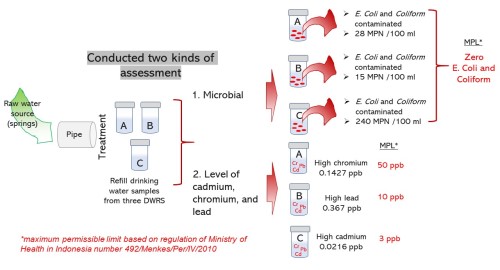
Assessment of microbial and level of Cadmium, Chromium and Lead contamination on drinking water refilling station in Bungus Teluk Kabung, West Sumatera, Indonesia
Abstract
Full Text:
PDFReferences
- L. C. Sima, M. Elimelech, More than a drop in the bucket: decentralized membrane-based drinking water refill stations in southeast Asia, Environ. Sci. Technol., 2013, 47, 7580–7588.
- W. Kusmawati, L. Rahayu, Contamination of Escherichia coli Drinking Water Refills on Drinking Water Depots in Malang City, Biogenesis, 2019, 7, 9-13.
- E. Apriliana, M. R. Ramadhian, M. Gapila, Bakteriological Quality Of Refill Drinking Water At Refill Drinking Water Depots In Bandar Lampung, JUKE., 2014, 4, 142-146.
- Ministry of Health Republic of Indonesia: Regulation Number 492/MENKES/PER/IV/2010 about Guideline for Drinking Water Quality, 2010.
- WHO, Guidelines for Drinking Water Quality: Third Edition, Incorporating the First and Second Addenda, Recommendations, World Health Organization, Geneva, 2008.
- Ministry of Health Republic of Indonesia: Regulation Number 43 about Hygiene and Sanitation of Refill Water Station, Jakarta, Indonesia, 2014.
- R. Wandrivel, N. Suharti, Y. Lestari, Kualitas Air Minum Yang Diproduksi Depot Air Minum Isi Ulang Di Kecamatan Bungus Padang Berdasarkan Persyaratan Mikrobiologi, Jurnal Kesehatan Andalas, 2012, 1, 129-133.
- A. Khoeriyah, Anies, Aspek Kualitas bakteriologis depot air minum isi ulang (DAMIU) di Kabupaten Bandung Barat, Majalah Kedokteran Bandung, 2015, 47, 137-144.
- R. A. Dewanti, L. Sulistyorini, Analisis Kualitas Bakteriologis Air Minum Isi Ulang Di Kelurahan Sememi, Kecamatan Benowo, The Indonesian Journal of Public Health, 2017, 12 , 39-50.
- R. S. Pakpahan, I. Picauly, I. N. W. Mahayasa, Escherichia coli Microbial and Total Coliform Bacterial Contamination of Refill Drinking Water, Kesmas: Jurnal Kesehatan Masyarakat Nasional, 2015, 9, 300-307.
- A. G. Bambang, Fatimawali, N. S. Kojong, Analisis Cemaran Bakteri Coliform Dan Identifikasi Escherichia Coli Pada Air Isi Ulang Dari Depot Di Kota Manado, PHARMACON : Jurnal Ilmiah Farmasi, 2014, 3, 325-334.
- N. A. Ismayanti, F. Kesumaningrum, Muhaimin, Analisis Kadar Logam Fe, Cr, Cd dan Pb dalam Air Minum Isi Ulang Di Lingkungan Sekitar Kampus Universitas Islam Indonesia Yogyakarta Menggunakan Spektrofotometer Serapan Atom (SSA), Ind. J. Chem. Anal., 2019, 2, 41-46.
- S. Bali, Kandungan Logam Berat (Timbal, Kadmium), Amoniak, Nitrit Dalam Air Minum Isi Ulang Di Pekanbaru, Health Care, 2012, 2,
-4.
- J. Briffa, E. Sinagra, R. Blundell, Heavy metal pollution in the environment and their toxicological effects on humans, Heliyon, 2020, 6, e04691.
- S. Chowdhury, M. A. J. Mazumder, O. Al-Attas, T. Husain, Heavy metals in drinking water: Occurrences, implications, and future needs in developing countries, Science of the Total Environment, 2016, 569, 476–488.
- A. Bernard, Cadmium & its adverse effects on human health, Indian Journal of Medical Research, 2008, 128, 557-564.
- G. Genchi, M. S. Sinicropi, G. Lauria, A. Carocci, A. Catalano, The Effects of Cadmium Toxicity, International journal of environmental research and public health, 2020, 17, 3782.
- A. Moldovan, M. A. Hoaghia, E. Kovacs, Ionut, C. Mirea, M. Kenesz, R. A. Arghir, A. Petculescu, E. A. Levei, O. T. Moldovan, Quality and Health Risk Assessment Associated with Water Consumption-A Case Study on Karstic Springs, Water, 2020, 12, 3510.
- P. Massányi, M. Massányi, R. Madeddu, R. Stawarz, N. Lukáč, Effects of Cadmium, Lead, and Mercury on the Structure and Function of Reproductive Organs, Toxics, 2020, 8, 94.
- WHO, Guidelines for Drinking Water Quality: Chromium in drinking water, World Health Organization, Geneva, 1996.
- A. Chiu, X. L. Shi, W. K. Lee, R. Hill, T. P. Wakeman, A. Katz, B. Xu, N. S. Dalal, J. D. Robertson, C. Chen, N. Chiu, L. Donehower, Review of Chromium (VI) apoptosis, cell-cycle-arrest, and carcinogenesis, J. Environ Sci. Health C. Environ. Carcinog. Ecotoxicol Rev., 2010, 28, 188-230.
- R. Shrivastava, R. K. Upreti, P. K. Seth, U. C. Chaturvedi, Effects of Chromium on the immune system, FEMS Immunology and Medical Microbiology, 2002, 34, 1-7.
- A. Zhitkovich, Chromium in Drinking Water: Sources, Metabolism, and Cancer Risks, Chem. Res. Toxicol., 2011, 24, 1617–1629.
- Y. Yulius, H. Prihatno, I. R. Suhelmi, Pola spasial kedalaman perairan di Teluk Bungus, kota Padang, Prosiding PIT VII ISOI 2010, 2010, 205-212.
- A. Putra, D. Hermon, W. Novarino, T. A. Tanto, Suitability of the spatial utilization on special zone (port) in the coastal region of bungus bay padang city, Jurnal kelautan Nasional, 2020, 15, 91-102.
- Departement Kesehatan RI, Petunjuk Pemeriksaan Bakteriologi Air, Pusat Laboratorium Kesehatan Departemen Kesehatan Republik Indonesia, Jakarta, 2000.
- J. M. Willey, L. M. Sherwood, C. J. Woolverton, Prescott, Harley, and Klein’s, Microbiology, New York: Mc Graw Hill, 2008, 272.
- Badan Standar Nasional, Cara Uji Cd dengan Spektrofotometri Serapan Atom (SSA), SNI 06-6989.16-2004.
- Badan Standar Nasional, Cara Uji Cr dengan Spektrofotometri Serapan Atom (SSA), SNI 06-6989.17-2004.
- Badan Standar Nasional, Cara Uji Pb dengan Spektrofotometri Serapan Atom (SSA), SNI 06-6989.8-2004.
- WHO, Guidelines for Drinking Water Quality: Lead in drinking water, World Health Organization, 2011.
- Y. Zhang, Y. P. Lin, Leaching of Lead from new unplasticized polyvinyl chloride (uPVC) pipes into drinking water, Environ. Sci. Pollut. Res., 2014, 22, 8405-8411.
- S. Y. I. Sari, D. K. Sunjaya, H. S. Furusawa, C. Watanabe, A. S. Raksanagara, Water Sources Quality in Urban Slum Settlement along the Contaminated River Basin in Indonesia: Application of Quantitative Microbial Risk Assessment, Journal of Environmental and Public Health, 2018, 1-7
DOI: http://dx.doi.org/10.13171/mjc02106041571aa
Refbacks
- There are currently no refbacks.
Copyright (c) 2021 Mediterranean Journal of Chemistry
